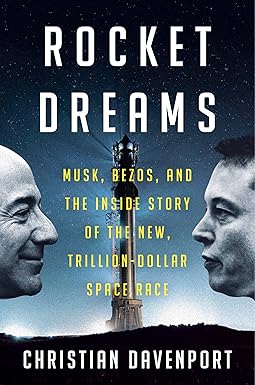Centauri Dreams
Imagining and Planning Interstellar Exploration
Gaia: Early Views, Big Prospects
We have several months yet before the European Space Agency’s Gaia mission enters its five-year operational phase. But you can see an important milestone in the image below. Gaia’s two telescopes have to be aligned and focused as its other instruments are calibrated. Testing involves downloading data like this image of NGC1818, a young star cluster in the Large Magellanic Cloud. The image covers an area something less than one percent of the spacecraft’s full field of view. Launched on December 19, 2013, Gaia now orbits around the L2 Lagrangian point some 1.5 million kilometers from Earth.
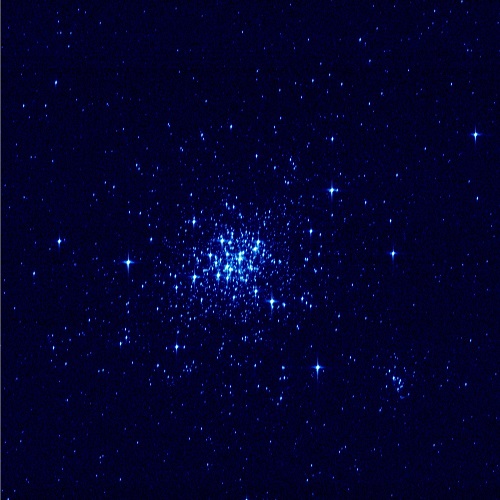
Image: A calibration image from Gaia is part of early testing of the mission’s systems. Credit: ESA/DPAC/Airbus DS.
Gaia inevitably makes me think of Hipparcos, an earlier ESA mission launched in 1989 devoted to precision astrometry, the measurement of proper motions and parallaxes of stars to help us figure out their distance and tangential velocity. What a far cry Hipparcos was from the days when Thomas Henderson, then observing at the Cape of Good Hope, was trying to measure the parallax of Alpha Centauri, all the while dueling with the German astronomer Friedrich Wilhelm Bessel to demonstrate that the method could give us a distance measurement to a star.
Bessel’s work on 61 Cygni took precedence but both astronomers proved that the closest stars could be measured using the instruments of their day. But measuring star positions from the ground has always been tough thanks to atmospheric effects and instrument limitations. And as we looked further and further from our own stellar neighborhood, these methods grew more challenging still, which is why proposals for a space mission devoted to astrometry began as early as 1967. The Hipparcos Catalog was released in 1997, covering precise measurements of almost 120,000 stars, with less precise readings on about a million more.
Now we have Gaia, which will chart 10,000 times as many stars as Hipparcos, with measurements of their position and motion that are 100 times more accurate. If all goes well, we should wind up with the largest three-dimensional map of the Galaxy ever created, charting one billion stars in terms of their distribution, brightness, temperature, composition and motion. Gaia should firm up our understanding of galactic structure while making numerous exoplanet finds and uncovering vast numbers of brown dwarfs. We can expect measurements of 500,000 quasars in the distant universe and, much closer to home, data on new asteroids.
It’s an ambitious mission, one that contains twin optical telescopes and their imaging system, a radial velocity spectrometer and blue/red photometers. The telescopes will focus their light onto a 106 CCD focal plane array with almost one billion pixels, making Gaia’s the largest digital camera yet deployed in space. The two telescopes will monitor each target star about 70 times over the five year mission, sweeping the entire sky in the process, their repeated measurements teasing out the parallax and true motion of each object. Objects down to magnitude 20 are in range, and according to this ESA backgrounder, the accuracy will range from 20 percent for stars near galactic center to 0.001 percent for stars closest to the Solar System.
Every one of Gaia’s billion stars will have been observed in the first six months of operations once calibrations are completed, but it’s the repeated observations over five years that will allow accurate determination of stellar distances and motion, with the final catalog not scheduled to be released until three years after the end of the mission. We need to keep a close eye on Gaia. It is essentially bringing our fuzzy maps of the Milky Way into much higher resolution, with implications for existing work like Kepler’s — Gaia will be able to give us accurate information about distance and motion for the planet-bearing systems Kepler has thus far found. A million gigabytes of data are in store as Gaia’s enormous catalog deepens our view of the galaxy.

Asteroid Re-Direct: Finding a Candidate
It was just a year ago, on February 15, 2013, that the 30-meter asteroid 2012 DA14 whisked past the Earth at a distance of well less than 30,000 kilometers, inside the orbits of our geosynchronous satellites. If you don’t recall 2012 DA14, it’s probably because it was later on the same day that the Chelyabinsk impactor struck, a 20-meter asteroid that released the energy of approximately 460 kilotons of TNT. Chelyabinsk made it into 2014 Olympic news at Sochi, with ten gold medals for February 15 winners being embedded with fragments from the object.
Today we get the passage of near-Earth asteroid 2000 EM26, whose closest approach will be covered by the Slooh network of automated telescopes starting at 2100 EST (0200 UTC), live from the Canary Islands. An iPad app is available or you can watch on Slooh.com, with the live image stream accompanied by commentary from astronomer Bob Berman and guests discussing the event and fielding questions from viewers using the hashtag #asteroid. Berman notes the significance of asteroid tracking and developing future mitigation strategies:
“On a practical level, a previously-unknown, undiscovered asteroid seems to hit our planet and cause damage or injury once a century or so, as we witnessed on June 20, 1908, and February 15, 2013. Every few centuries, an even more massive asteroid strikes us — fortunately usually impacting in an ocean or wasteland such an Antarctica. But the ongoing threat, and the fact that biosphere-altering events remain a real if small annual possibility, suggests that discovering and tracking all NEOs, as well as setting up contingency plans for deflecting them on short notice should the need arise, would be a wise use of resources.”
The Challenge of Asteroid Capture
With almost 11,000 near-Earth objects now discovered, the astronomical community continues its work on planetary defense. The Asteroid Redirect Mission (ARM) is NASA’s bid to find a small asteroid that can be parked in a lunar orbit for study and thorough exploration in the 2020s. This JPL news release gives us more information about ARM’s current status, noting two possible scenarios: An entire small asteroid could be captured and redirected into lunar orbit, or a large boulder or other mass from a larger asteroid could be retrieved and put into a similar orbit.
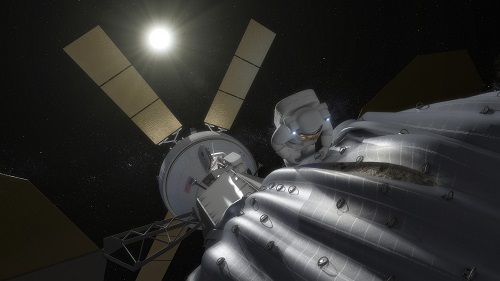
Image: This concept image shows an astronaut preparing to take samples from the captured asteroid after it has been relocated to a stable orbit in the Earth-moon system. Hundreds of rings are affixed to the asteroid capture bag, helping the astronaut carefully navigate the surface. Credit: NASA/JPL.
But finding the right asteroid is tricky business. Most near-Earth asteroids are either too large or in unsuitable orbits, and would-be targets can move out of range of our instruments so fast that it becomes a challenge to get enough data to make the call. The goal is something smaller than about twelve meters across, says Paul Chodas, a senior scientist in the Near-Earth Object Program Office at JPL. He adds: “There are hundreds of millions of objects out there in this size range, but they are small and don’t reflect a lot of sunlight, so they can be hard to spot. The best time to discover them is when they are brightest, when they are close to Earth.”
The news release goes through the detection and analysis process. The coordinates of objects detected by asteroid surveys flow to the Minor Planet Center in Cambridge, MA, where the objects can be tagged as previously known or else given a new designation. Orbit, intrinsic brightness and other data are then refined by the Near-Earth Object Program Office at JPL, which updates its online small body database. Now in place for the projected asteroid redirect mission is a new screening process that scans for candidate objects.
Radar observations by the Deep Space Network at Goldstone (CA) or Arecibo Observatory in Puerto Rico can produce further data on orbit and size if they are able to track the asteroid, but other observatories both professional and amateur may also be asked to look at it. The Infrared Telescope Facility at Mauna Kea can provide details on spectral type, reflectivity and likely composition. Several dozen 6- to 12-meter asteroids are thought to fly by the Earth at a distance closer than the Moon every year, but few of these are in suitable orbits for the ARM mission.
Even so, the wave of new technology now approaching should make finding the right object a sure thing. Lindley Johnson (Near-Earth Objects Program, NASA headquarters) notes what we can expect:
“The NASA-funded Catalina Sky Survey, which has made the majority of NEO discoveries since its inception in 2004, is getting an upgrade. We also will have new telescopes with an upgraded detection capability, like PanSTARRS 2 and ATLAS, coming online soon, and the Defense Advanced Research Projects Agency’s new Space Surveillance Telescope will give us a hand as well.”
And don’t forget our old friend WISE, which I usually write about in terms of brown dwarfs in the Sun’s vicinity. The repurposed spacecraft now functions as NEOWISE and may help in characterizing targets for the redirect mission.
Potential candidates are being flagged at the rate of about two per year, a number that is bound to climb as these further resources come into play. We’ll then have a target and a plan as we proceed in our efforts to characterize these objects. NASA is assuming that an Orion spacecraft and Space Launch System (SLS) rocket will make asteroid capture happen, but whatever the hardware, studying small asteroids up close — and ultimately developing strategies for nudging the trajectories of much larger objects — is a vital part of future planetary defense.

Starships on Earth
Building a starship takes us along an evolutionary path as we master the myriad methods of its creation. And the process does not start at some arbitrary point in the future. Rather, it begins now as we put today’s technologies to work in the service of new concepts. Living ‘meta-technologies’ offer a way into the enclosed but verdant spaces of a worldship. In the essay below, Centauri Dreams regular Rachel Armstrong looks at current projects that explore the kind of biospheres a worldship will entail, and discusses enriched ecosystems that form ‘a new kind of Nature.’ Dr. Armstrong is co-director of AVATAR (Advanced Virtual and Technological Architectural Research) in Architecture & Synthetic Biology at the University of Greenwich, London. She completed clinical training at the John Radcliffe Medical School at Oxford in 1991, and in 2009 began PhD work in chemistry and architecture at University College London.
by Rachel Armstrong

“Why are you crying grandma?”
“I’m not!” The old woman quickly rubbed the back of her hand over a thin gleaming trail on her cheek. “There’s a lot of dust in the air thrown up by those sky hooks! They’re on the move again!”
Several teams of construction workers were using hover diggers to loosen the foundations of what looked like a small hill. They chopped into the humus like a pack of dogs looking for bones, levering sections of earth upwards before finding a new soil horizon to work on. Gradually, they started to expose a porous rock-like framework that was heavily covered with vegetation and subterranean organic matter.
“Where are they taking the Green Hollow now?” asked the child, as troupes of day-glow labourers swung by safety threads from the steel grabber that was making clumsy pinching movements above them.
The afternoon sun was making it difficult to see the details of the architecture, which was rising like a great shadow over the landscape. It no longer appeared green but black, except for where chemically sculptured nurturing light tracks passed through it.
“Up to Persephone, way beyond Earth’s orbit,” replied the old woman. “They’ve been growing the organs for that worldship interior for as long as I can remember. When I was your age, I even remember helping the boiler-suited workers plant the solutions by hand that would form her bones and tissues in the ground beneath us now. They told me that if I looked after them and kept them well fed with scraps of organic matter, then the Green Hollow would grow up big and strong.”
“Like feeding ducks?” asked the child.
The old woman nodded. “Yes, but you have to sow the duck seed to grow the birds first – then feed them!”
…………………………………………
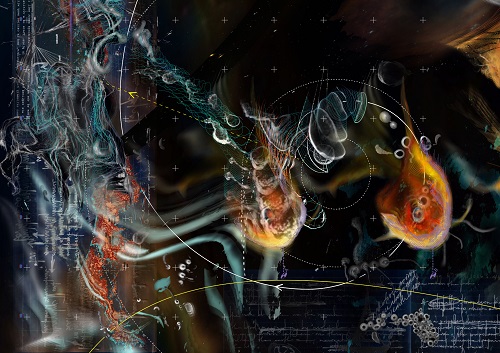
Image: This and other artwork in this essay by Elizabeth Anne Williams.
If we are unable to live ‘sustainably’ on a life-bearing planet – then how do we propose to live amongst the stars, or construct environments so they may become fertile – such as worldships?
At the start of the third millennium we are entering the next stage of human expansion. The scale and speed of our development, with the global spread of industrial processes, is catalyzing a new stage of metabolic evolution for R. Buckminster Fuller’s readymade ‘spaceship earth’ [1]. Yet, the industrial processes that support our growth are collectively ‘reverse terraforming’ our native life support system, such as by releasing stored carbon dioxide from fossil fuels on geological scales [2]. While James Lovelock and Lynn Marguils observed that Earth’s biosphere is a self-regulating system [3], its ability to respond to challenges operates within definable limits and the pressure of human development appears to currently be exceeding the homeostatic capabilities of our planetary system. Specifically, after 150 years of industrialization, our natural systems are being drained to feed our rapidly expanding urban populations with life-sustaining water, fertile soils and minerals [4]. Indeed, owing to the fundamental nature of these infrastructures, space engineering and architecture converge on the shared challenges in designing our life-support systems – which are centred on the issue of ‘sustainability’.
Sustainable development is a relatively new concept that has been emphasized by an awareness of resource constraints in the late 20th century. It invites questions about how current generations can meet their own needs as well as securing the welfare of future generations. Yet, the 1987 Brundtland Report [5] uses general terms to describe the nature of ‘sustainable’ development – as enabling the current generation to meet its own needs without compromising the ability of future generations to provide for themselves. This has precipitated a variety of different approaches to achieve these aims in the practice of the built environment ranging from the biological metaphors of biomimicry, to the decoration of our living spaces with elements from rural vistas in green roofs and walls.
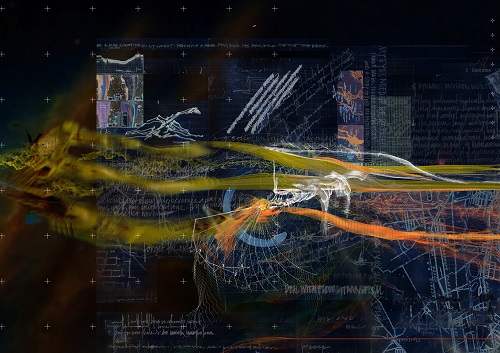
Some methods incorporate the conservation of materials or resources, while others explore a variety of ways to improve the mechanical efficiency of systems. So, when considering a long-term pathway for establishing models of sustainable development, it is worth remembering that the concepts and practices that form ‘sustainable’ narratives are still very much in evolution.
Yet, the prevalent paradigm of sustainability operates according to the principles of resource conservation and operates as a ‘better’ kind of industrialization. In the absence of approaches that directly enrich our ecosystems, we are compromising the ability of generations to provide for themselves. Indeed, only a very few systems have been designed that can support sustained living in resource constrained environments. These ‘biospheres’ are technologically constructed, closed and controlled experiments, which propose to help us manage the Earth’s resources better. Potentially they enable us to establish ecosystems beyond the Earth’s surface and include projects such as BIOS-3 [6] and Biosphere 2 [7]. The price of these constructed environments helps append a monetary value to the services provided by natural ecosystems. For example, the International Space Station, which may be regarded as a biosphere that is regularly topped up with fresh resources, has cost between $100-150 billion [8] and during the Biosphere 2 project $9,000,000 was spent on each crew member per year [9].
Yet, such valuations cannot convey the investment made by Earth’s systems in producing a life-bearing planet. These have been made over billions of years through processes that we do not fully understand. The outcome of these natural systems is a range of priceless technologies that are formed from the integration of natural forces, which transform one set of substances into another through the process of metabolism and include soils, forests and crude oil [10]. Recently, we have been able to manipulate living systems at such small scales and with such precision that we are starting to understand how we may apply living processes as a kind of 21st century technology in ways that reinforce the actions of natural systems. By developing this new toolset potentially, in the longer term, human development may be synonymous with an increase in planetary fertility.
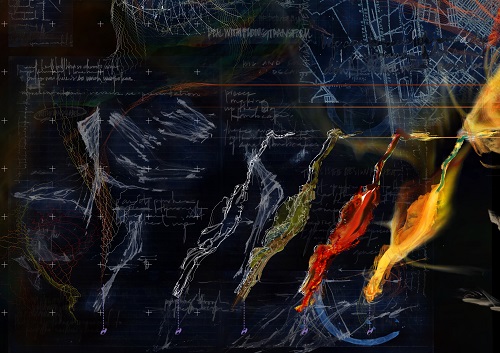
‘Ecopoiesis’ is the science that studies the transformation of inert terrains such as the Martian surface into life-bearing ones [11].To facilitate the production of life-promoting systems, these principles could also be applied to other lifeless terrains, such as metallic starship interiors, or the concrete surfaces of cities.
Indeed, life-enhancing habitats are a fundamental requirement for architectural projects in resource-constrained environments, and many principles can be explored on Earth’s surface without incurring the costs and extra degrees of technological difficulty associated with building non-terrestrial habitats. Indeed, an experimental approach to the design of buildings to increase environmental fertility and promote new ways of thinking about closed ecological systems could be developed by multi-disciplinary teams of researchers where multiple stakeholders – from space agencies, to property owners – may benefit from the construction challenges, ecological discoveries and post-occupancy evaluations in the pursuit of life-promoting architectures. While some novel materials with lifelike properties already exist as commercial products, such as Mycoform [12], which is a building material produced from compacted fungal mycelium, many innovations in bioprocessing are still prototypes. This presents a wealth of new opportunities for the exploration of new concepts in sustainability.
One such project is a collaboration between Astudio architects, Sustainable Now Technologies, AVATAR (Advanced Virtual And Technological Architectural Research) group at the University of Greenwich and the students at the Twickenham Academy in London, which applies an experimental algaeponics technology – the Greenstone Device – in an architectural context. This prototype cutting edge biotechnology system was designed specifically for the Twickenham Academy 6th form as a way of fixing 1 metric ton of carbon every 2.2. years. The facility provides students with access to state of the art, sustainable technology that forms the basis for unique project work that are integral to the 6th form curriculum. Students use the Greenstone Device to strudy the economics of carbon capture to the range of products generated by the technology.

The questions raised by this integrated algaeponics project may be relevant to space programs – in the short and long term – that are investigating the possibilities of aqueous ecosystems in extra-terrestrial environments. For example, the European Space Agency’s MELISSA (Micro-Ecological Life Support Systems Alternative) project, seeks to produce food and reclaim minerals, water and oxygen through bioprocessing systems using waste matter such as, faeces, urea and carbon dioxide [13]. Extending the space research into terrestrial settings through a combined research program could expand our knowledge of constructing closed system ecologies and help develop next generation expertise in a new portfolio of materials, infrastructures, technologies and economic models. These may help us develop life-promoting habitats across a range of environments that span from the Earth to the stars.
Yet the impacts of possible new fusions and collaborations may also produce more immediate impacts on our urban living spaces, since lifelike technologies require similar kinds of infrastructures to fully alive systems. For example, bioprocesses require circulation of nutrient supplies through streams of air and water, which could take place within the walls of our homes [14]. Setting up non-equilibrium conditions within the fabric of our buildings enables them to be more than containers for living processes but to act as bioprocessing sites, which can perform a whole range of useful tasks that can be thought of as extended ‘organs’ to digest waste, recycle water, remove environmental toxins and even provide food for their inhabitants.
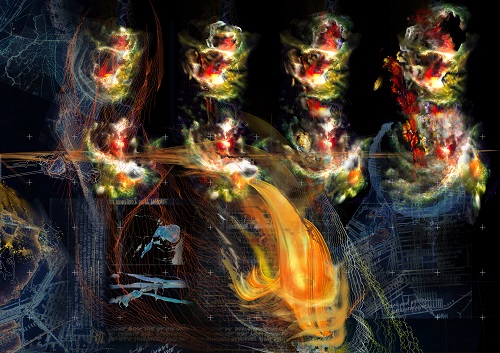
Moreover, lively building fabrics with metabolisms and physiologies do not need to be monstrous edifices. They could constitute a quiet revolution, which is locally produced and shaped by maker communities of bio hackers that are already developing experimental prototypes in their bedrooms, such as Cathal Garvey’s synthetic biology laboratory in Cork [15]. They may simply creep up quietly on our living spaces to infiltrate forgotten and under imagined spaces such as roofs, cavity walls and gaps under floorboards. Nor do they have to exist without aesthetic sensibilities. The Dutch electronics company Phillips proposes that our next generations of biochemical digesters will be so beautiful they will be on display in our homes. For example, bioluminescent bacteria may be housed in vials of beautiful hand-blown glass cells, which use waste that is generated in the average home to produce low-level, mood-elevating light [16].
Indeed, an immediate investment in developing the conceptual and technological infrastructures to produce life-promoting environments may have far reaching benefits in the long term – where buildings are sites for micro agricultures that produce rich, fertile fabrics, such as soils and coral reefs. In turn, these may provide a native infrastructure that possesses the richness and diversity that enrich existing ecosystems and could be considered to exist within a spectrum of natural processes as a new kind of Nature. Indeed, the mutually reinforcing approaches that exist at the intersection between space research and sustainable architecture, may help us better understand how to design, engineer and inhabit closed system ecologies through the design and prototyping of post natural fabrics, which could be prototyped within the everyday context of our swelling cities. For example, the opportunities for material fertility within micro sites may be enhanced by orchestrating the flow and transformation of matter through them in a large range of forms such as, synthetic soils grown from complex chemistries, entanglements of silicon circuitry and cell cultures, or green plants with bead-like metallic micro batteries.
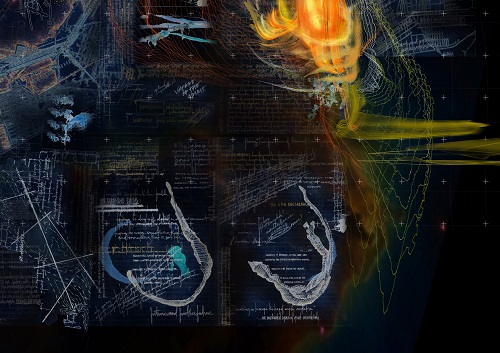
These heterogeneous fabrics may eat with us, breathe, age and feel alongside us. They may process our biochemistry as if they were our own native extended organs and embody aesthetic preferences that convey our desires and betray our emotions because they are woven through our own design. Indeed, the diversity and versatility of their configurations may not only help us increase the liveability of our surroundings and establish fundamental principles for the construction of synthetic ecosystems in every conceivable environment but offer us new survival strategies that support this current wave of human expansion. Yet, we do not have to wait for starships to be realised before we conduct these ecological experiments. Rather we can create a liveable legacy for today’s sustainability challenges by changing our expectations of our cities, habitats and ecosystems to create new, evolvable foundations that weave together the territories between the Earth and stars through living toolsets.
The developments that take us beyond this planet do not need to be conducted within a vacuum. Indeed, it makes economic and scientific sense to prototype new ideas within the resource-challenged sites of our current cities, where our learning can be extended across generations of architects, engineers and scientific researchers. The outcomes of these explorations will inform the construction principles, substrates and technologies necessary for the development of habitable worldship interiors and the principles that will enable us to transform barren environments into ones that can support new kinds of life. Indeed, weaving starship fabrics into our cities will enable us to seed life throughout the cosmos, long before the first colonies ever leave our home planet.
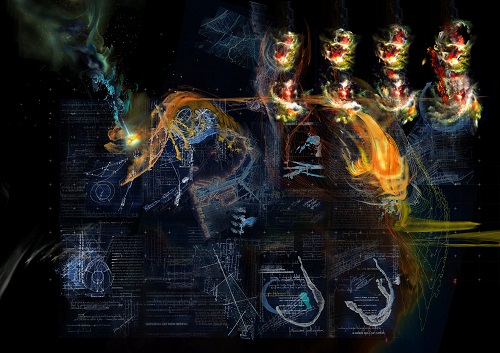
…………………………………………
“It’s scary!” remarked the child, gripping his grandmother’s hand.
“I suppose so.” Mused the old woman, noting how the striking absence of life made the gaping hole where the Green Hollow had once been seem particularly ominous. “But, they’ll start to fill it with duck seed soon!” She smiled reassuringly.
Two skyhooks appeared to walk like giants towards them, rocking in their seven league boots above the horizon. Both grips were clutching tankers of fluid. The day-glow crews moved like spiders on threads between them, guiding and cajoling the monsters until they towered over the cavity in the ground.
An all-terrain-vehicle drove up to the bystanders and an official wearing a peaked olive green cap barked at them to stand back and mind the spray when the tanker contents were discharged into the quarry. He handed them some porous paper face masks, which made everyone look like chickens.
“Planting a new structure was a much simpler operation when I was young!” remarked the grandmother under her paper beak, as the boy wondered what kinds of adventures he might have in a hard peaked hat.
Several long, thin-legged walkers braved the rich spray as the tanker contents were discharged. They deftly folded several layers of a football-pitch sized membrane into the rapidly filling hole that was impregnated with bacterial spores. As the waters rose, the walkers’ legs retracted and became cantilevers that braced their bodies in a flotation formation. They continued to knit and tuck the membranes into the fluid as they also seeded and folded hardy microorganisms in the muddy eddy of the uterine pit. Yet, unlike the lifeless scar left by the quarry, the goo itself was vibrant, feeding and evolving. Even within the first minutes of its existence, strange tubular embryonic forms were starting to yaw, roll and involute like a rising cake mix. By the time the walkers stretched their legs again, the contents of the pit had set like a gel and small birds were nervously landing on its trembling surface, gorging on eluted earthworms.
“Is all the seed in the hole now?” asked the boy.
“I think so,” replied his grandmother as the official swung his arm low, motioning to the public that they could remove their face shields.
“So, what happens now?”
“We wait,” she said.
——-
References
[1] Fuller, R.B. 2008. Operating manual for spaceship earth, Zürich: Lars Muller Publishers.
[2] US National Research Council. 2010. Advancing the science of climate change, America’s climate choices. Washington: National Academies Press. [online] Available at: [Accessed 18 April 2013]. p3.
[3] Lovelock, J. 2000. Gaia: A new look at life on earth, Oxford: Oxford Paperbacks.
[4] Lovelock, J. 2009. The vanishing face of Gaia, New York: Basic Books.
[5] World Commission on Environment and Development.1987. Our common future. Report of the World Commission on environment and development. Published as Annex to General Assembly document A/42/427. Available at: http://www.un-documents.net/our-common- future.pdf. [Accessed 25 April 2013].
[6] Prado, M.E. 1983-2003. Russian CELSS Studies. [online] Available at: http://www.permanent.com/russian-celss.html. [Accessed 22 December 2014].
[7] Avise, J.C. 1994. The real message from Biosphere 2, Conservation Biology, 8(2) pp. 327-329.
[8] European Space Agency. No date. How much does it cost? International Space Station? Human Spaceflight. [online] Available at: http://www.esa.int/Our_Activities/Human_Spaceflight/International_Space_Station/
How_much_does_it_cost. [Accessed 22 December 2013].
[9] Avise, J.C. 1994. The real message from Biosphere 2. Conservation biology, 8(2), p. 327-329. See also Keim, B. 20 April 2009. Biosphere 2 not such a bust. Wired. [online] Available at: http://www.wired.com/wiredscience/2009/04/biospheresci/. Available 26 December 2013].
[10] I am applying the term ‘technology’ to refer to a total cosmic infrastructure of artificial and natural forces that may be harnessed to perform useful work. Heidegger, M. 1978. Being and Time, New Ed. Oxford: Wiley-Blackwell.
[11] Fogg, M.J., “Dynamics of a Terraformed Martian Biosphere,” Journal of the British Interplanetary Society, 46, 293-304 (1993).
[12] Mycoform. No date. Terreform. [online] Available at: http://www.planetaryone.com. [Accessed 27 December 2013].
[13] MELISSA. 8 February 2006. Advanced Life Support, European Space Agency. [online] Available at: http://ecls.esa.int/ecls/?p=melissa. [Accessed 27 December 2013].
[14] This possibility was discussed earlier in a piece on Living Technology.
[15] Regalada, A. 14 February 2012. Doing biotech in my bedroom. MIT Review. Available at: http://www.technologyreview.com/news/426885/doing-biotech-in-my-bedroom/. [Accessed 27 December 2013].
[16] Muppala, S.C. 1 December 2011. Glowing Bioluminescent Bacteria Brings Hope of a New Power-efficient Lighting System. Medindia [online] Available at: http://www.medindia.net/news/Glowing-Bioluminescent-Bacteria-Brings-Hope-of-a-New-Power-efficient-Lighting-System-94186-1.htm#ixzz2etJ33aFN. [Accessed 12 September 2013].

Mapping Ganymede
The first global geological map of Ganymede has become available through the efforts of a team led by Wes Patterson (Johns Hopkins Applied Physics Laboratory) and Geoffrey Collins (Wheaton College). The map doesn’t reproduce well in the small space I have available, but the image below gives you an idea of its layout and is linked to the download site at the U.S. Geological Survey, which is publishing it as USGS Scientific Investigations Map 3237.
Image: Ganymede is the largest satellite of Jupiter, and its icy surface has been formed through a variety of impact cratering, tectonic and possibly cryovolcanic processes. Images of Ganymede suitable for geologic mapping were collected during the flybys of Voyager 1 and Voyager 2 (1979), as well as during the Galileo mission in orbit around Jupiter (1995-2003). This map represents a synthesis of scientists’ understanding of Ganymede geology after the Galileo mission. Credit: Wheaton College/JHUAPL/Brown University/JPL/USGS.
Ganymede is now the fourth planetary satellite to be mapped after our own Moon as well as the Jovian satellites Io and Callisto, a feat made possible by synthesizing data from multiple missions including the Voyagers and Galileo. The striking nature of Ganymede’s terrain is obvious from the contrast between lighter regions marked by grooves and ridges and apparently older, darker cratered areas. A map like this reminds us that the features we’re looking at are evidence not only of the moon’s internal changes but its interactions with the other Galilean satellites and the various small objects that have impacted its surface along the way.
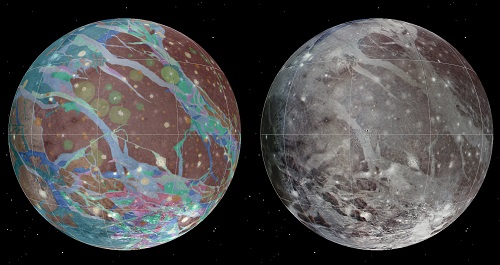
Image: To present the best information in a single view of Jupiter’s moon Ganymede, a global image mosaic was assembled, incorporating the best available imagery from Voyagers 1 and 2 and Galileo spacecraft. This image shows Ganymede centered at 200 west longitude. This mosaic (right) served as the base map for the geologic map of Ganymede (left). Credit: USGS.
Good maps, of course, are always refined as we collect better data, and on that score, we’re continuing to follow the fortunes of JUICE, the Jupiter Icy Moons Explorer, a planned European Space Agency mission selected in May 2012 with a proposed launch in 2022, arriving in the Jovian system in 2030. While JUICE is going to be studying Callisto and Europa as well, the plan is for the spacecraft to enter orbit around Ganymede after its other maneuvers in the system. A possible Ganymede Lander mission from the Russian Space Research Institute is also in the cards, although whether it becomes a partner to JUICE or flies at all is still in question.

Image: This is a natural color view of Ganymede from the Galileo spacecraft during its first encounter with the satellite. North is to the top of the picture, and the sun illuminates the surface from the right. The dark areas are the older, more heavily cratered regions, and the light areas are younger, tectonically deformed regions. The brownish-gray color is due to mixtures of rocky materials and ice. Bright spots are geologically recent impact craters and their ejecta. The finest details that can be discerned in this picture are about 13.4 kilometers across. The images that make up this color photo were taken in June 1996. Credit: NASA/JPL.
The three moons to be visited by the JUICE mission are all the site of possible oceans beneath their ice, governing the instrument choices aboard the spacecraft, which will include cameras, spectrometers, a laser altimeter and an ice-penetrating radar. A dozen flybys are planned for heavily-cratered Callisto, and the mission’s two flybys of Europa will include measurements of the thickness of the ice crust. Settling in by 2033 into orbit around Ganymede, JUICE will not only study the moon’s structure but its magnetic and plasma interactions with Jupiter. Ganymede is the only moon in the Solar System known to generate its own magnetic field.

Image: NASA’s Pluto-bound New Horizons spacecraft spied Jupiter’s moon Ganymede on February 27, 2007, from 3.5 million kilometers (2.2 million miles) away. The original scale was 17 kilometers per pixel, and the image is centered at Ganymede coordinates 6 degrees south, 38 degrees west. Ganymede, the largest moon in the solar system, has a dirty ice surface cut by fractures and peppered by impact craters. Credit: NASA/JHUAPL/Southwest Research Institute.
I include the image above because it’s a reminder how reliant we are on a small number of missions to get the data needed for the Ganymede map. We can only hope that JUICE flies per schedule and delivers what would obviously be a major data upgrade. Meanwhile, seeing the New Horizons image of Ganymede, taken as the spacecraft whisked past the Jovian system in 2007, gives renewed cause for celebration that all systems aboard that craft are sound as we prepare for next year’s flyby of Pluto/Charon and, let’s hope, a KBO encounter beyond.

SETI at the Particle Level
A big reason why the Fermi paradox has punch is the matter of time. Max Tegmark gets into this in his excellent new book Our Mathematical Universe: My Quest for the Ultimate Nature of Reality (Knopf, 2014), where he runs through what many thinkers on the subject have noted: Our Sun is young enough that countless stars and the planets that orbit them must have offered homes for life long before we ever appeared. With at least a several billion year head start, wouldn’t intelligent life have had time to spread, and shouldn’t its existence be perfectly obvious by now?
Tegmark’s book is fascinating, and if you’re interested in learning why this dazzling theorist thinks it likely we are the only intelligent life not just in our galaxy but in our universe, I commend it to you (although Fermi issues play only the tiniest of roles in its overall themes). I’ll have plenty of occasion to get into Tegmark’s ideas about what he believes to be not just a multiverse but a multiply-staged multiverse (i.e., four different kinds of multiverse) in coming days. But today I want to look at yet another Fermi speculation, this one by the Australian artificial intelligence researcher Hugo de Garis.
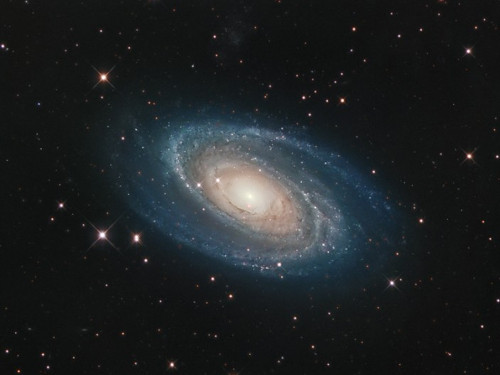
Image: The spiral galaxy M81 would seem to offer countless possible environments for life. But is there a SETI case to be made not just on the galactic level, but on the level of the very small? Image credit & copyright: Giovanni Benintende.
If SETI is giving us no evidence of extraterrestrials, maybe it’s because we’re looking on too large a scale. What if, in other words, truly advanced intelligence, having long ago taken to non-biological form, finds ways to maximize technology on the level of the very small? Thus de Garis’ interest in femtotech, a technology at the level of 10-15 meters. The idea is to use the properties of quarks and gluons to compute at this scale, where in terms of sheer processing power the improvement in performance is a factor of a trillion trillion over what we can extrapolate for nanotech.
I leave you to the two de Garis essays listed at the end of this article for the particulars on how this might be accomplished, including thoughts on moving beyond femtotech to ‘attotech’ and even what he calls ‘zeptotech’ (using possibly existing force particles that would mediate the grand unified force of the electroweak force and the color force; i.e., the strong nuclear force). It turns out that the vast improvement from nanotech to femtotech is based on factors like the density being a million cubed times greater, while the signaling speed between femto components would be a million times faster because such components are so much closer together, and so on.
If artilects are the future of biological life forms — their successors, actually — then wouldn’t there be pressure to gradually downgrade to nanotech scale (nanolects) and eventually to femtotech levels? Such a ‘downgrade’ is actually an upgrade, of course, and continuing to downgrade as far as possible would only make sense as long as huge performance gains can be achieved.
Thus de Garis’ conclusion (the italics are his):
The hyper intelligences that are billions of years older than we are in our universe (which is about 3 times older than our sun), have probably “downgraded” themselves to achieve hugely greater performance levels. Whole civilizations may be living inside volumes the size of nucleons or smaller.
Given this perspective, conventional SETI through radio or even Dysonian methods (i.e., looking for the signatures of macro-engineering, as recently discussed in these pages in Jason Wright’s Glimpsing Heat from Alien Technologies) begins to look incomplete. Indeed, de Garis refers to it as ‘provincial,’ arguing that while he would not want the SETI effort to be canceled, he does believe that any radio-emitting civilizations out there are most likely not the most intelligent beings in the universe. To find the truly advanced civilizations, we would need to look on the level of the very small:
Therefore I recommend that humanity start thinking about ways to detect their presence. We need a SIPI, a Search for Infra Particle Intelligence. For example, why are the elementary particles such “carbon copies” of each other, for each particle type? Once one starts “seeing” intelligence in elementary particles, it changes the way one looks at them, and the way one interprets the laws of nature, and the interpretation of quantum mechanics, etc. It’s a real paradigm shift away from looking for non human intelligence in outer space, to looking for it in inner space, i.e. SIPI.
I remember lively discussions with several fellow writers over the years on the question of whether we might miss an extraterrestrial civilization’s signature because it was small. Indeed, one colleague speculated, the Earth itself could be under intense observation through a nanotechnology network that would be completely outside our range of observation. Where SIPI brings us is into a realm where even nanotech seems like a bulky and rather clumsy way to proceed. It’s a Fermi solution wild enough to galvanize many a future SETI conversation.
The relevant essays are de Garis, “Femtotech: Computing at the Femtometer Scale
Using Quarks and Gluons” (full text available at kurzweilai.net) and “X-Tech and the Search for Infra Particle Intelligence” (available at h+ Magazine).

Unusually Red Brown Dwarfs (and What They Tell Us)
As we continue to learn more about brown dwarf atmospheres, the dwarf ULAS J222711-004547 catches the eye because of its unusually red appearance. What Frederico Marocco (University of Hertfordshire) and team have learned through observations with the Very Large Telescope in Chile is that a thick layer of clouds in the upper atmosphere is responsible for its tint. Marocco’s data analysis tells us we are seeing clouds made up of mineral dust. In this UH news release, he specifically mentions enstatite and corundum. The clouds are floating in a hot atmosphere of water vapor, methane and possible ammonia.
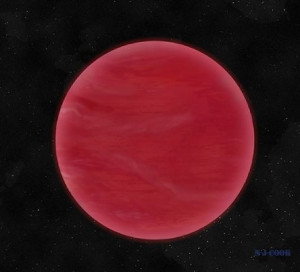
This brown dwarf may turn out to be uncommonly helpful. Thus Avril Day-Jones, a colleague of Marocco’s at the University of Hertfordshire, who contributed to the analysis:
“Being one of the reddest brown dwarfs ever observed, ULAS J222711-004547 makes an ideal target for multiple observations to understand how the weather is in such an extreme atmosphere. By studying the composition and variability in luminosity and colours of objects like this, we can understand how the weather works on brown dwarfs and how it links to other giant planets.”
Image: Artist’s impression of ULAS J222711-004547. This newly discovered brown dwarf is characterized by an unusually thick layer of clouds, made of mineral dust. These thick clouds give ULAS J222711-004547 its extremely red colour, distinguishing it from “normal” brown dwarfs. Credit: Neil J Cook, Centre for Astrophysics Research, University of Hertfordshire.
Digging into the paper on this work gets us into brown dwarf evolution over time. Keep in mind that brown dwarfs, unable to ignite fusion in their core, cool down over time, so that they evolve along the spectral sequence from M to L, T and Y class objects (ULAS J222711-004547 turns out to be what the paper refers to as ‘a peculiar L dwarf’). The point is that the relationship between mass and spectral type is tricky with objects smaller than stars. An L-class object might be an old low-mass star, a young high-mass brown dwarf, or even a young planet.
Marocco’s team believes the brown dwarf in question falls into a category becoming known as ‘unusually red L dwarfs’ (URLs), with only nine of this class thus far identified. It is also unlikely to be a young object. And here’s where we get into what Day-Jones is talking about in terms of studying giant planets. From the paper (with internal references omitted for brevity):
Planetary-mass objects show similar near-infrared colours, like 2M1207b…and the HR8799 planets…and their photometric and spectroscopic properties are believed to be heavily influenced by the atmospheric condensates…URLs can therefore be considered a ‘bridge’ between brown dwarfs and giant planets atmospheres, thus a useful test bed for the atmospheric models. Also, these objects can be used as probes to understand the physics of dust clouds, and to disentangle the effects of surface gravity and metallicity in the L-type temperature regime.
Assuming high dust content in the photospheres of these unusually red brown dwarfs, the Hertfordshire team is able to derive a grain size in the atmosphere in the range of 0.5 ?m. The paper suggests that both URLs and giant planets are characterized by thick clouds in the uppermost atmospheric layers, “probably caused by a combination of slightly low gravity and high metallicity.” As we learn more about how dust clouds form and behave in ultracool atmospheres, we’re probing the atmospheric dynamics of gas giant planets as well. Expect growing emphasis on variability studies as we examine how clouds move on these objects.
The paper is Marocco, “The extremely red L dwarf ULAS J222711?004547 – dominated by dust,” Monthly Notices of the Royal Astronomical Society, published online February 5, 2014 (full text).


